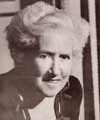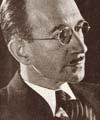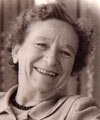Our History
Origins, Theory, and Practice: 1943 - Present
by Jay S. Kwawer, Ph.D.

The William Alanson White Institute was founded in 1943 as a revolutionary alternative to mainstream, orthodox Freudian psychoanalysis in the United States. Its internationally renowned founders, Erich Fromm, Ph.D., Frieda Fromm-Reichmann, M.D., Harry Stack Sullivan, M.D., David Rioch, M.D., Janet M. Rioch, M. D., and Clara Thompson, M.D., united by a passionate spirit of dissent, saw the need to challenge the parochial sectarianism and growing rigidity of American psychoanalysis. Some had trained in the European Freudian circle in the 1920s and 1930s and all were actively and prominently involved as teachers in the orthodox, "official" institutes of the American Psychoanalytic Association in New York City and the Washington-Baltimore area. They opposed what they perceived to be inflexibility in clinical practice, intellectual insularity, a paternalistic system of training, and the domination of organized medicine over psychoanalytic training and practice. In response, they created an institute based on the Freudian tradition, enriched by the interdisciplinary perspectives of the social sciences.
 The White Institute is best known in the profession for the "interpersonal" point of view, developed in response to the prevailing notion of the distant, formal, "blank screen" analyst who is devoid of human presence
The White Institute is best known in the profession for the "interpersonal" point of view, developed in response to the prevailing notion of the distant, formal, "blank screen" analyst who is devoid of human presence  in the treatment relationship. The study of how people influence and respond to one another remains a central focus of the interpersonal treatment model. The interpersonal approach underscores the human qualities of the psychoanalyst as a factor in therapeutic change. By emphasizing the relationship with the patient, psychoanalysts at the Institute have made pioneering contributions to the treatment of profoundly disturbed patients who were generally considered unreachable or incurable. Some of the earliest studies of countertransference, the influence of the psychoanalyst's personality on the treatment process, also evolved organically from the interpersonal viewpoint.
in the treatment relationship. The study of how people influence and respond to one another remains a central focus of the interpersonal treatment model. The interpersonal approach underscores the human qualities of the psychoanalyst as a factor in therapeutic change. By emphasizing the relationship with the patient, psychoanalysts at the Institute have made pioneering contributions to the treatment of profoundly disturbed patients who were generally considered unreachable or incurable. Some of the earliest studies of countertransference, the influence of the psychoanalyst's personality on the treatment process, also evolved organically from the interpersonal viewpoint.

By the 1950s, the White Institute was known for its distinctly interdisciplinary viewpoint. White Institute theorists, including its founders, wedded the perspectives of society and culture to more traditional psychoanalytic understandings of personality development. This emphasis challenged the orthodox view that treated patients as if family, culture, and societal influence were unimportant. At that time, orthodox practitioners of mainstream psychoanalysis were primarily treating affluent patients. The Institute's Clinical Services (established in 1948) realized the Institute's commitment to studying varieties of individual development, providing community service, and adapting psychoanalytic methods to the treatment of underserved populations.
In the 1950s, this challenge to organized psychoanalysis prompted efforts by the orthodox American Psychoanalytic Association to disenfranchise and marginalize the Institute's leaders and teachers. Aided by legal representation from former U.S. Supreme Court Justice Abe Fortas (an early White Institute trustee) and distinguished Yale Law School Professor Walton Hamilton, the Institute threatened a lawsuit on the basis of monopolistic restraint of trade and forced the American Psychoanalytic to retreat. Strengthened by this struggle to survive, the Institute secured its institutional autonomy and integrity. By the 1960s, its graduates were represented on the faculty and administration of major residency training programs in psychiatry and doctoral programs in clinical psychology throughout the New York area. They have continued to direct a variety of these programs over the years and have inspired many students to continue their postdoctoral education at White.
Students trained at the Institute join the distinguished ranks of alumni who have made exceptional contributions to the field of psychoanalysis. White Institute graduates participated actively in the founding of the American Academy of Psychoanalysis in the 1950s, the International Federation of Psychoanalytic Societies in the 1960s, and the Division of Psychoanalysis ("Division 39") of the American Psychological Association in the 1980s. They are now well-represented in the governance and scientific activities of these organizations.
For several decades, the White Institute was the only nationally prominent psychoanalytic training center offering full training to psychologists identical to that of medical candidates. This commitment to interdisciplinary training long pre-dated a landmark class action lawsuit in the 1980s that resulted in institutes affiliated with the more orthodox American Psychoanalytic Association opening their doors to "non-medical" students.
Despite the growing incursions through the 1990s of managed care and "quick fix" psychopharmacological intervention, Institute candidates have continued to pursue intensive postdoctoral training program in psychoanalysis. Because self-awareness is a goal of treatment at White, all candidates are required to undergo a personal psychoanalysis aimed at freeing practitioners from personal, emotional difficulties that could hamper their work with patients.
Candidates are also closely supervised in their treatment of patients, many of whom are seen through the Institute's low-cost Clinical Services. They work intensively with some of these patients for three or more times weekly for several years. Candidates also learn to apply the Institute's psychoanalytic perspectives to the treatment of problems that may not require such intensive or extensive treatment. Much of their supervised work is psychoanalytically-informed psychotherapy (in which patients may be seen less frequently than they typically are in psychoanalysis), using treatment methods adapted to both clinical intervention with specific problems and consultations with couples, families, and organizations.
In keeping with the Institute's innovative approach to treatment, graduates continue to eschew treatment based on clinical detachment and instead seek to establish the safe, trusting, personal relationships needed by people whose lives are in distress. As an educational and intellectual center, White maintains the highest standards in training practitioners. Freed by its institutional autonomy, the Institute has developed and defined its own training standards. These standards are widely emulated by newer training institutes around the U.S. and have more recently been adopted as the training standard endorsed by the inter-professional consortium of psychoanalytic training centers nationwide. Institute graduates take on major teaching and administrative responsibilities at hospitals, clinics, and universities throughout the New York City area, around the nation, and throughout the world.
The social services orientation of the Institute that emerged in the 1950's was reflected in many of its unique programs and treatment service offerings. In the 1960's, White offered a treatment program for college students who dropped out of school for psychological reasons that affected their ability to work and attend classes. In 1962, the Institute also initiated The Union Therapy Project to serve the mental health needs of industrial labor union members through short-term therapy based on analytic principles. This program was active for more than 25 years.
In response to more recent societal and psychological issues and pressures, the Institute has continued to develop specialized treatment services that now include The Eating Disorders, Compulsions & Addictions Service; The HIV Service; The Japanese Psychotherapy Service; The Lifespan Development Service; The Living with Medical Conditions Service; The Psychoanalytic Psychotherapy for Artists Service; The Sexual Abuse Service; The Trauma Service; and The Child and Family Center.
Today, The William Alanson White Institute still represents the most progressive wing of the psychoanalytic profession in the country. Institute faculty teach a wide range of views in psychoanalysis, building on the Freudian perspective and encouraging controversy, theoretical diversity, and challenge to intellectual dogma. Unlike many psychoanalytic training centers, White maintains institutional autonomy and theoretical integrity by remaining a free-standing, self-governing institution. After more than 70 vibrant, productive years, its teaching, treatment programs, and scholarship continue to reflect the creativity and courage that first brought the Institute to life.

